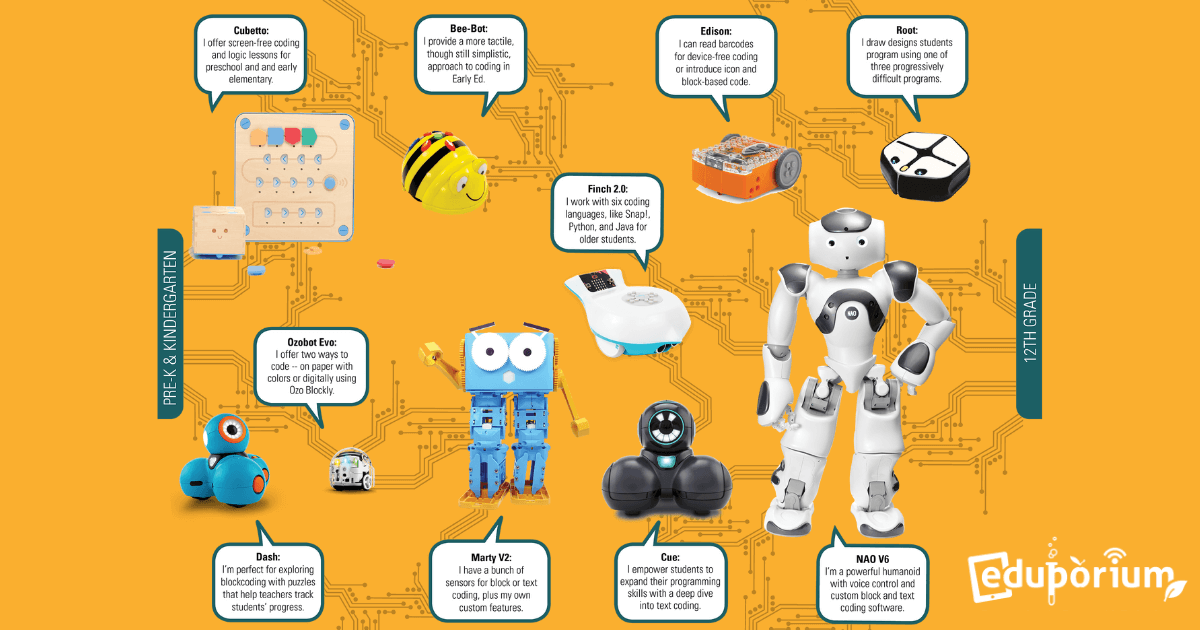Educational robotics kits are incredibly valuable for teaching students the skills they really need to know. They're useful for shaping problem solving skills, creativity, and, most importantly, coding. The best part? Students can use robotics tools in any grade—starting in Pre-K with super simple models and continuing through high school with the more complex tools. Don't worry—we've broken it all down for you below!
Due to the rise in STEM education, there are robotics kits available for everyone. This allows educators to start students young and encourage them to grow every year while learning new skills. The robotics tools for education these days follow the same type of progression. They're simple enough to engage kids as early as Pre-K and evolve to prepare high schoolers for the next step.
Starting in early education.
Using robotics to its full potential in the classroom can be tricky, so we've put together a timeline with suggestions for which robots students should be using based on the grade they're in. There is no reason for teachers to shy away from introducing kids to this innovative form of learning because it seems to be too challenging or not relevant enough to their learning. Neither premonition is true as robotics is often as easy as knowing shapes and beneficial since it involves coding.
The progression begins in Pre-K with a friendly and extremely simple robot called the Cubetto. This wooden robot on wheels teaches toddlers that shapes and colors can serve as code to help a robot move. Then, there's the Bee-Bot, which is made for five- and six-year-olds, and teaches them how to do some basic programming using its on-board, tactile buttons for controlling its directional movements.
Moving on to robotics for elementary students.
The next level of the progression is targeted at kids in grades 1-3. To give them the best learning experience possible, we recommend using the Edison or Root Robot and Wonder Workshop's Dash. The Root gives kids an additional element to connected play and helps them learn coding through block-based challenges. And, the innovative Dash Robot helps them build on what they've already learned, mixing in an introduction to drag-and-drop programming.
Once children master the first two levels, they're ready for the Ozobot Evo and Edison Robot in Level 3. By now, they're in fourth, fifth, or maybe even sixth grade, so these tools are perfect to take their robotics and coding skills up another notch. Using the Ozobot Evo, students can engage in simple color coding to get the Ozobot to navigate a maze and then, as they get more skilled, use the Blockly programming language to make it move using only the programs they create. The Edison Robot also involves online programming and, using its free software called EdWare, kids can create online programs, transfer them to their robot, and watch as it shows them what the power of programming can do!
Robotics kits for high school students.
The fourth and final level of the progression helps high school students to take the final step and learn some of the more complex components of robotics. First up, we have the Marty Robot V2, which students can program using the Python language. Students can teach it anything from recognizing colors to dancing when it sees a certain student walk in the room. Last, but not least, there's the NAO Robot V6, the Cue Robot, and the Finch Robot 2.0. The NAO is a very advanced humanoid robot that moves as fluidly as a human and can walk and talk. It knows tons of various commands and students can even teach it more, making NAO an incredibly powerful classroom tool. Students can program the Cue using JavaScript and try both Java and Python with the Finch 2.0.
To learn more about our robotics progression system and staying consistent with robotics education, visit our classroom robotics page.



